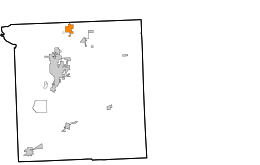Picher, Oklahoma | |
|---|---|
 A view looking north along Connell Ave, which was the main business district, 2007. The Picher Water Tower stands in the background. | |
 Location within Ottawa County showing former municipal boundaries | |
| Coordinates: 36°58′58″N 94°49′58″W / 36.98278°N 94.83278°W | |
| Country | United States |
| State | Oklahoma |
| County | Ottawa |
| Area | |
| • Total | 2.2 sq mi (5.8 km2) |
| • Land | 2.2 sq mi (5.8 km2) |
| • Water | 0.0 sq mi (0.0 km2) |
| Elevation | 823 ft (251 m) |
| Population | |
| • Total | 20 |
| • Density | 9.1/sq mi (3.4/km2) |
| Time zone | UTC-6 (Central (CST)) |
| • Summer (DST) | UTC-5 (CDT) |
| ZIP code | 74360 |
| Area code(s) | 539/918 |
| FIPS code | 40-58550[3] |
| GNIS feature ID | 1096611[1] |

South Treece Street, 2008
Picher is a ghost town and former city in Ottawa County, northeastern Oklahoma, United States. It was a major national center of lead and zinc mining for more than 100 years in the heart of the Tri-State Mining District.
Decades of unrestricted subsurface excavation dangerously undermined most of Picher's town buildings and left giant piles of toxic metal-contaminated mine tailings (known as chat) heaped throughout the area. The discovery of cave-in risks, groundwater contamination and health effects associated with the chat piles and subsurface shafts resulted in the site being included in 1983 in the Tar Creek Superfund site by the US Environmental Protection Agency.
The state collaborated on mitigation and remediation measures, but a 1994 study found that 34% of the children in Picher suffered from lead poisoning due to these environmental effects, which could result in lifelong neurological problems.[4] Eventually, the EPA and the state of Oklahoma agreed to a mandatory evacuation and buyout of the entire township.
A 2006 Army Corps of Engineers study showed 86% of Picher's buildings (including the town school) were badly undermined and subject to collapse at any time.[5] The destruction in May 2008 of 150 homes by an EF4 tornado accelerated the exodus of the remaining population.[6]
On September 1, 2009, the state of Oklahoma officially dis-incorporated the city of Picher, which ceased official operations on that day. The population plummeted from 1,640 at the 2000 census to 20 at the 2010 census. The federal government proceeded to conduct buyouts of remaining properties. As of January 2011, six homes and one business remained, their owners having refused to leave at any price. Except for some historic structures, the rest of the town's buildings were scheduled to be demolished by the end of the year. One of the last vacant buildings, which had housed the former Picher mining museum, was destroyed by arson in April 2015. Its historical archives and artifacts had already been shipped to the Dobson Museum in Miami, Oklahoma by that point.[citation needed]
Picher is among a small number of locations in the world (such as Gilman, Colorado; Centralia, Pennsylvania; and Wittenoom, Western Australia) to be evacuated and declared uninhabitable due to environmental and health damage caused by mining.[citation needed]
The closest towns to Picher, other than nearby fellow ghost towns Cardin, Treece and Douthat, are Commerce, Quapaw (the headquarters of the federally recognized Native American nation by that name), and Miami, Oklahoma.
- ^ a b U.S. Geological Survey Geographic Names Information System: Picher, Oklahoma
- ^ "2010 City Population and Housing Occupancy Status". U.S. Census Bureau. Retrieved March 26, 2012.[dead link]
- ^ "U.S. Census website". United States Census Bureau. Retrieved January 31, 2008.
- ^ Saulny, Susan (September 13, 2009). "Welcome to Our Town. Wish We Weren't Here". The New York Times. Retrieved July 11, 2021.
- ^ "Archived copy" (PDF). www.environment.ok.gov. Archived from the original (PDF) on December 5, 2008. Retrieved January 17, 2022.
{{cite web}}: CS1 maint: archived copy as title (link) - ^ Service, US Department of Commerce, NOAA, National Weather. "Picher Tornado May 10, 2008". weather.gov. Retrieved April 20, 2018.
{{cite web}}: CS1 maint: multiple names: authors list (link)